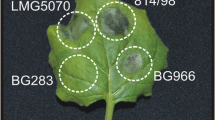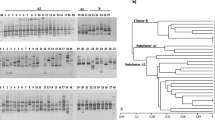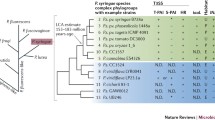Abstract
One hundred and sixty strains of Pseudomonas syringae subsp. savastanoi from Olea europaea, Olea europaea var. sylvestris, Nerium oleander, Fraxinus angustifolia and Retama sphaerocarpa, and four type strains of other pathovars were studied, investigating 102 phenotypic traits, among which we include biochemical characteristics, assimilation of different carbon sources, sensitivity or resistance to antibiotics and indoleacetic acid (IAA) production. Results were analysed with an affinity dendrogram via the Jaccard coefficient. They indicate an influence of environmental factors on the formation of the 15 phenons obtained, since isolated (knot) strains from the same species but different geographical areas are segregated. Segregation, also detected in strains from different hosts within the same area, added to the pathogenicity test helps to characterise these strains as different pathovars.
Similar content being viewed by others
References
Bauer AW, Kirby WMM, Sherris JC and Turck M (1966) Antibiotic susceptibility testing by a standardized simple disk method. Amer J Clin Pathol 45: 493-496
Beltrá R (1959) El ácido beta-indol acético y los tumores vegetales de origen bacteriano. Revista Latinoam Microbiol 2: 23-32
Caponero A, Contesini AM and Iacobellis NS (1995) Population diversity of Pseudomonas syringaesubsp. savastanoion olive and oleander. Plant Pathology 44: 848-855
Comai L and Kosuge T (1980) Involvement of plasmid Deoxyribonucleic Acid in Indolacetic Acid synthesis in Pseudomonas savastanoi. J Bacteriol 143: 950-957
Comai L and Kosuge T (1982) Cloning and characterization of 'iaaM', a virulence determinant of Pseudomonas savastanoi. J Bacteriol 149: 40-46
Comai L, Surico G and Kosuge T (1982) Relation of plasmid DNA to Indolacetic Acid production in different strains of Pseudomonas syringae pv. savastanoi. J Gen Microbiol 128: 2157-2163
Dye DW, Bradbury JF, Gato M, Hayward AC, Lelliot RA and Schroth MN (1980) International standards for naming pathovars of phytopathogenic bacteria and a list of pathovar names and pathotype strains. Annu Rev Plant Pathol 59: 153-168
Ercolani GL (1983) Variability among Isolates of Pseudomonas syringaepv. savastanoifrom the Philloplane of the Olive. J Gen Microbiol 129: 901-916
García de los Ríos JE (1989) Estudios acerca de la tuberculosis del olivo. Tesis Doctoral. Universidad Complutense de Madrid
Gardan L, Cottin S, Bollet C and Hunault G (1991) Phenotypic heterogeneity of Pseudomonas syringaevan Hall. Res Microbiol 142: 995-1003
Gordon SA and Weber RP (1951) Colorimetric estimation of indolacetic acid. Plant Phisiol 26: 192-195
Hardy RWF, Burns RC and Holsten RD (1971) Applications of acetylene-ethylene assay for measurement of nitrogen fixation. 12th. Symp. Nitrogen Econ. Plant Comm. Pac. Sc. Cong. Camberra
Iacobellis NS, Sisto A, Surico G, Evidente A and Di Maio E (1994) Pathogenicity of Pseudomonas syringaesubsp. savastanoimutants defective in phytohormone production. J Phytopathol 140: 238-248
Iacobellis NS, Contesini AM and Surico G (1995) Bacteriocin production by Pseudomonas syringaesubsp. savastanoi. Phytopathol Med 34: 15-22
Janse JD (1981) The bacterial disease of ash (Fraxinus excelsior), caused by Pseudomonas syringaesubsp. savastanoipv. fraxini, II. Etiology and taxonomic considerations. Eur J Forest Pathol 11: 425-438
Janse JD (1982) Pseudomonas syringaesubsp. savastanoi(ex Smith) subsp. nov. rev., the bacterium causing excrescences on Oleaceae and Nerium oleanderL. Inter J Systematic Bacteriol 32: 166-169
Janse JD (1991) Pathovars discrimination within Pseudomonas syringaesubsp. savastanoiusing whole-cell fatty acids and pathogenicity as criteria. Systematic and Applied Microbiol 13: 79-84
Mac Donald EMS, Powell GK, Regier DA, Glass NL, Roberto F, Kosuge T and Morris RO (1986) Secretion of zeatin, ribosylzeatin, and ribosyl-10-methylzeatin by Pseudomonas savastanoi. Plant Physiology 82: 742-747
Magie AR, Wilson EE and Kosuge T (1963) Indolacetamide as an intermediate in the synthesis of indolacetic acid in Pseudomonas savastanoi. Science 141: 1281-1282
Mugnai L, Giovanetti L, Ventura S and Surico G (1994) The grouping of strains of Pseudomonas syringaesubsp. savastanoiby DNA restriction fingerprinting. J Phytopathol 142: 209-218
Powell GK and Morris RO (1986) Nucleotide sequence and expression of a Pseudomonas savastanoicytokinin biosynthetic gene, homology with Agrobacterium tumefacienstmr and tzs loci. Nucleic Acids Research 6: 225-235
Smidt M and Kosuge T (1978) The role of indole-3-acetic acid accumulation by alpha methyl tryptophan resistant mutants of Pseudomonas savastanoiin gall formation on oleanders. Physiol Plant Pathol 13: 203-214
Smith EF (1908) Recent studies of the olive-tubercle organism. Bull US Dept Agr Bur Plant Ind 131: 25-43
Sneath PHA and Sokal RR (1973) Numerical taxonomy. The principles and practice of numerical classification. Freeman & Co., San Francisco
Surico G, Iacobellis NS and Sisto S (1985) Studies on the role of indole-3-acetic acid and cytokinins in the formation of knots on olive and oleander plants by Pseudomonas syringaepv. savastanoi. Physiol Plant Pathol 26: 309-320
Surico G and Iacobellis NS (1992) Phytohormones and olive knot disease. In: Verma DPS, (ed.) Molecular Signals in Plant-Microbe Communications. Boca Raton, FL, USA: CRC Press, 209-227
Sutic D and Dowson DJ (1963) The reaction of olive, oleander and ash, cross inoculated with some strains and forms of Pseudomonas savastanoi(Smith) Stevens. Phytopathologische Zeitschrift 46: 305-314
Wells JM, Casano FJ and Surico G (1991) Fatty acid composition of Pseudomonas syringaepv. savastanoi. J Phytopathol 133: 152- 162
Wilson EE (1965) Pathological histogenesis in oleander tumors induced by Pseudomonas savastanoi. Phytopathology 55: 1244- 1249
Young JM, Dye DW, Bradbury JF, Panagopoulos CG and Robbs CF (1978) A proposed nomenclature and classification for plant pathogenic bacteria. N. Z. J Agric Res 21: 153-177
Young JM, Bradbury JF, Davis RE, Dickey RS, Ercolani GL, Hayward AC and Vidader AK (1991) Nomenclatural revisions of plant pathogenic bacteria and list of names 1980-1988. ISPP Subcommitee on Taxonomy of Phytopathogenic Bacteria. Rev Plant Pathology 70: 211-221
Author information
Authors and Affiliations
Rights and permissions
About this article
Cite this article
Alvarez, F., García de los Ríos, J., Jimenez, P. et al. Phenotypic variability in different strains of Pseudomonas syringae subsp. savastanoi isolated from different hosts. European Journal of Plant Pathology 104, 603–609 (1998). https://doi.org/10.1023/A:1008604011154
Issue Date:
DOI: https://doi.org/10.1023/A:1008604011154




